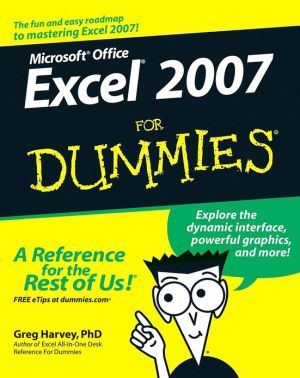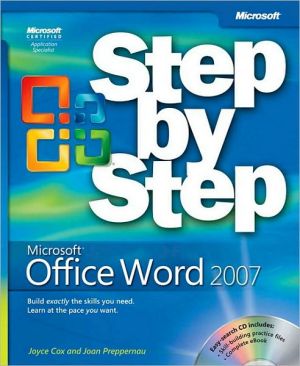Data Analysis and Decision Making with Microsoft Excel, Revised (with CD-ROM and Decision Tools and Statistic Tools Suite)
Master data analysis, modeling, and spreadsheet use with DATA ANALYSIS AND DECISION MAKING WITH MICROSOFT EXCEL! With a teach-by-example approach, student-friendly writing style, and complete Excel integration, this quantitative methods text provides you with the tools you need to succeed. Margin notes, boxed-in definitions and formulas in the text, enhanced explanations in the text itself, and stated objectives for the examples found throughout the text make studying easy. Problem sets and...
Search in google:
Master data analysis, modeling, and spreadsheet use with DATA ANALYSIS AND DECISION MAKING WITH MICROSOFT EXCEL! With a teach-by-example approach, student-friendly writing style, and complete Excel integration, this quantitative methods text provides you with the tools you need to succeed. Margin notes, boxed-in definitions and formulas in the text, enhanced explanations in the text itself, and stated objectives for the examples found throughout the text make studying easy. Problem sets and cases provide realistic examples that enable you to see the relevance of the material to your future as a business leader. The CD-ROMs packaged with every new book include the following add-ins: the Palisade Decision Tools Suite (@RISK, StatTools, PrecisionTree, TopRank, and RISKOptimizer); and SolverTable, which allows you to do sensitivity analysis. All of these add-ins have been revised for Excel 2007. Booknews Developed by the authors for an MBA course taught at Indiana University, this text illustrates different types of statistical methods for analyzing data sets, touching on regression analysis, decision making under uncertainty, linear programming, and simulation. The material is example-driven with statistics problems solved using commercial add-ins for Excel. The CD-ROM contains StatPro 2.0 and the Decision Tools suite of software add-ins. Annotation c. Book News, Inc., Portland, OR (booknews.com)
Part I: GETTING, DESCRIBING, AND SUMMARIZING DATA. Introduction to Data Analysis and Decision Making. 1. Introduction. An Overview of the Book. The Methods. The Software. A Sampling of Examples. Modeling and Models. Conclusion. 2. Describing Data: Graphs and Tables. Introduction. Basic Concepts. Frequency Tables and Histograms. Analyzing Relationships with Scatterplots. Time Series Graphs. Exploring Data with Pivot Tables. Conclusion. 3. Describing Data: Summary Measures. Introduction. Measures of Central Location. Quartiles and Percentiles. Minimum, Maximum, and Range. Measures of Variability: Variance and Standard Deviation. Obtaining Summary Measures with StatTools. Measures of Association: Covariance and Correlation. Describing Data Sets with Boxplots. Applying the Tools. Conclusion. 4. Getting the Right Data. Introduction. Sources of Data. Excel Tables for Filtering, Sorting, and Summarizing. Complex Queries with the Advanced Filter. Importing External Data from Access. Creating Pivot Tables from External Data. Web Queries. Other Data Sources on the Web. Cleansing the Data. Conclusion. Part II: PROBABILITY, UNCERTAINTY, AND DECISION MAKING. 5. Probability and Probability Distributions. Introduction. Probability Essentials. Distribution of a Single Random Variable. An Introduction to Simulation. Distribution of Two Random Variables: Scenario Approach. Distribution of Two Random Variables: Joint Probability Approach. Independent Random Variables. Weighted Sums of Random Variables. Conclusion. 6. Normal, Binomial, Poisson, and Exponential Distributions. Introduction. The Normal Distribution. Applications of the Normal Distribution. The Binomial Distribution. Applications of the Binomial Distribution. The Poisson and Exponential Distributions. Fitting a Probability Distribution to Data: BestFit. Conclusion. 7. Decision Making Under Uncertainty. Introduction. Elements of a Decision Analysis. The PrecisionTree Add-In. Bayes' Rule. Multistage Decision Problems. Incorporating Attitudes Toward Risk. Conclusion. Part III: STATISTICAL INFERENCE. 8. Sampling and Sampling Distributions. Introduction. Sampling Terminology. Methods for Selecting Random Samples. An Introduction to Estimation. Conclusion. 9. Confidence Interval Estimation. Introduction. Sampling Distributions. Confidence Interval for a Mean. Confidence Interval for a Total. Confidence Interval for a Proportion. Confidence Interval for a Standard Deviation. Confidence Interval for the Difference Between Means. Confidence Interval for the Difference Between Proportions Controlling Confidence Interval Length. Conclusion. 10. Hypothesis Testing. Introduction. Concepts in Hypothesis Testing. Hypothesis Tests for a Population Mean. Hypothesis Tests for Other Parameters. Tests for Normality. Chi-Square Test for Independence. One-Way ANOVA. Conclusion. Part IV: REGRESSION, FORECASTING, AND TIME SERIES. 11. Regression Analysis: Estimating Relationships. Introduction. Scatterplots: Graphing Relationships. Correlations: Indicators of Linear Relationships Simple Linear Regression. Multiple Regression. Modeling Possibilities. Validation of the Fit. Conclusion. 12. Regression Analysis: Statistical Inference Introduction. The Statistical Model. Inferences About the Regression Coefficients. Multicollinearity. Include/Exclude Decisions. Stepwise Regression.The Partial F Test. Outliers. Violations of Regression Assumptions. Prediction. Conclusion. 13. Time Series Analysis and Forecasting. Introduction. Forecasting Methods: An Overview. Testing for Randomness. Regression-Based Trend Models. The Random Walk Model. Autoregression Models. Moving Averages. Exponential Smoothing. Seasonal Models. Winters' Exponential Smoothing Model. Conclusion. Part V: DECISION MODELING. 14. Introduction to Optimization Modeling. Introduction. Introduction to Optimization. A Two-Variable Model. Sensitivity Analysis Properties of Linear Models. Infeasibility and Unboundedness. A Product Mix Model. A Multiperiod Production Model. A Comparison of Algebraic and Spreadsheet Models. A Decision Support System. Conclusion. 15. Optimization Modeling: Applications. Introduction. Workforce Scheduling Models. Blending Models. Logistics Models. Aggregate Planning Models. Financial Models. Integer Programming Models. Nonlinear Models. Conclusion. 16. Introduction to Simulation Modeling. Introduction. Real Applications of Simulation. Probability Distributions for Input Variables. Simulation with Built-In Excel Tools. Introduction to @RISK. The Effects of Input Distributions on Results. Conclusion. 17. Simulation Models. Introduction. Operations Models. Financial Models. Marketing Models. Simulating Games of Chance. Conclusion.
\ BooknewsDeveloped by the authors for an MBA course taught at Indiana University, this text illustrates different types of statistical methods for analyzing data sets, touching on regression analysis, decision making under uncertainty, linear programming, and simulation. The material is example-driven with statistics problems solved using commercial add-ins for Excel. The CD-ROM contains StatPro 2.0 and the Decision Tools suite of software add-ins. Annotation c. Book News, Inc., Portland, OR (booknews.com)\ \








